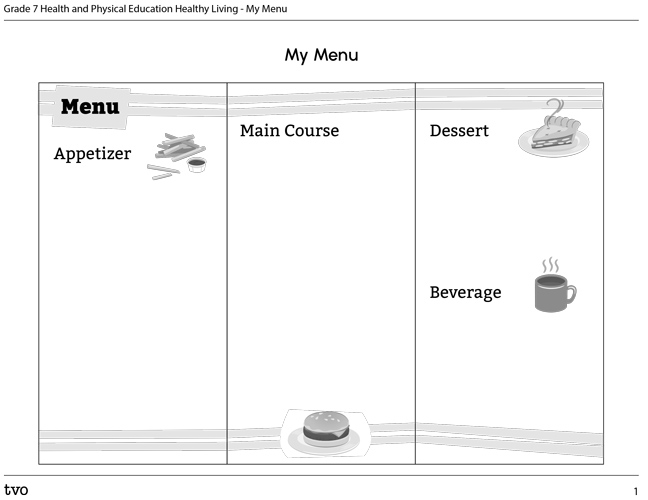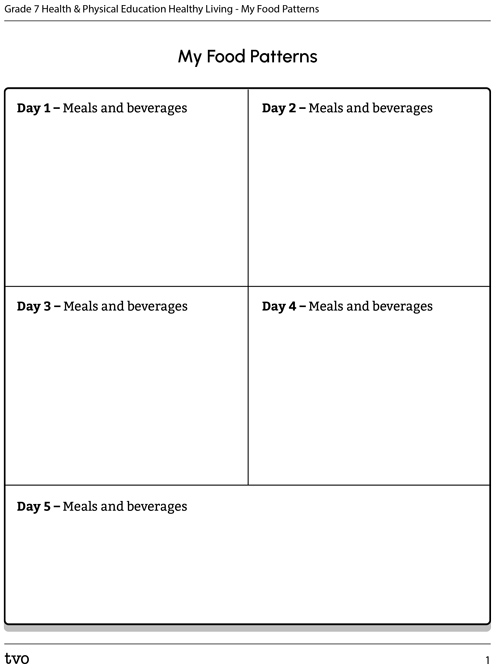Minds On
Making healthy choices

A plate of food is divided into three sections. Half of the plate is fruits and vegetables. An arrow pointing to the fruit and vegetables reads “Have plenty of vegetables and fruits.” A quarter of the plate is meats and proteins. An arrow pointing to the protein section reads “Eat protein foods.” Finally, another quarter of the plate is made of grains. An arrow pointing to the grains section reads “Choose whole grain foods.” Beside the plate is a glass of water. An arrow pointing to the water reads “Make water your drink of choice.”
Eating a healthy, balanced diet is important.
Press ‘Diet’ to reveal what this word means.
Diet is food and drinks that are regularly consumed by individuals.
Reflect on the following statement:
“Healthy eating is more than just the food we eat.”
What are ways to make healthy choices when it comes to healthy eating?
Create a KWL chart to review what you Know and what you Want to know about healthy eating. Do not fill in the L column until you have completed the Action section.
Use the updated Canada Food Guide (2019) to guide your response.
Complete the KWL Chart in your notebook or using the following fillable and printable document. You can also use another method of your choice to record your ideas.
| What do I know about making healthy food choices? | What do I want to know about making other healthier food choices? | What have I learned about healthy eating beyond eating healthy? |
|---|---|---|
|
Reflect on the statement: “Healthy eating is more than just the food we eat.” |
||
|
What are other ways you can make healthier choices when it comes to healthy eating? |
||
Press the ‘Activity’ button to access KWL Chart.
Action
Taking preventative measures
A person’s eating patterns can have a positive effect on their overall physical and mental health, but they can also contribute to health problems.
Healthy foods should be a part of a regular diet as they give the vitamins, minerals, and nutrients needed to be healthy — both in mind and in body.
When people do not regularly engage in healthy eating, they are creating an unhealthy eating pattern. An unhealthy eating pattern is one of the many factors, including obesity, physical inactivity, smoking, and high blood pressure, that can increase the risk of illness and disease.
Check your knowledge
Consider the following health disorders. Which ones do you think can be linked to eating patterns and habits?
Health disorders associated with eating habits
Select one of the health disorders that is associated with eating habits. You can use the information provided for some of these health disorders or you can complete your own research. If searching on your own, find websites that are associated with medical professionals.
As you explore the information, consider the questions. Record your thinking using a method of your choice.
- What causes the health disorder?
- How can following healthier eating habits reduce the severity of the disorder?
- Based on what you know about the health disorder, what advice could be given to someone looking to improve their eating habits? Explain.
Press the following tabs to access information on different health disorders associated with eating habits.

Observational studies have shown that eating a great deal of certain foods can increase the likelihood of cancer. These foods include foods that are high in sugar and refined carbohydrates (such as white flour, white rice, pastas, sodas, and breakfast cereals).
Processed meats such as hot dogs, bacon, ham, and some deli meats, when eaten in large amounts have been linked to an increase in the likelihood of cancers such as colorectal cancer (colon cancer).

Type 2 Diabetes is when the body develops a resistance to insulin, which means that sugar in the body cannot be regulated. It is a hormone produced naturally in the body that controls the amount of sugar in the body.
Several studies have shown that consuming a lot of fast food and high-sugar foods increases the likelihood of Type 2 Diabetes.
Skipping a healthy breakfast and snacking on high calorie foods has also been linked to a greater likelihood of developing Type 2 Diabetes.

A diet that is high in calories, includes very little fruit and vegetables but does include many oversize portions, is a diet that is linked to weight gain. When this weight gain reaches a level where it has a negative effect on a person’s health, it is considered obesity.
Obesity occurs when calorie intake is always higher than the number of calories burned through exercise and daily activities. Obesity left untreated can lead to other health concerns such as Type 2 Diabetes, depression, and certain types of cancers.
Healthy eating
As you have learned, unhealthy eating patterns can lead to an increase in the likelihood of health disorders.
How can people create healthy eating patterns?
According to the Canada Food Guide, a diet filled with nutritious food is what is needed to create healthy eating patterns and reduce the likelihood of developing health related disorders. Regularly eating healthy foods gives you the vitamins, minerals, and nutrients you need to be healthy.
These nutritious foods include:
- vegetables
- fruit
- whole grains
- proteins (plant-based proteins as often as possible)

This image includes the proteins that are considered nutritious foods.
Foods that contain mostly healthy fats should replace foods that contain mostly saturated fat. Saturated fat foods contain a high amount of fatty acid and is considered less healthy than non-saturated fat.
Nutritious food can be frozen, dried, canned, or fresh and reflects cultural preferences and food traditions.
Show what you know!
Select the correct answer, then press 'Check Answer' to see how you did.
Pause and Reflect
Pause and reflect
Return to your KWL chart from the Minds On section and complete the L column that includes learning from this activity.
Did any of your questions from the W section get answered?
| What do I know about making healthy food choices? | What do I want to know about making other healthier food choices? | What have I learned about healthy eating beyond eating healthy? |
|---|---|---|
Consolidation
Redesign your favourite menu

Reflect on what you have learned about the importance of developing healthy eating habits and how it relates to preventing a variety of health disorders.
With this information in mind, redesign items from a restaurant menu that you find online. Choose at least four items to make a meal. For example, you might choose an appetizer, main course, dessert, and beverage or you might choose three appetizers and a dessert. Consider how the meal could be altered to be healthier, yet still be appealing to you and others.
Consider healthy choices such as:
- the preparation method of the food items from the menu (e.g., baked vs. fried options)
- redesigning the food items so that your meal models the Canada Food Guide recommendations (half fruits and/or vegetables, one quarter protein, one quarter whole grains)
- removing processed foods for healthier options
Complete the My Menu in your notebook or using the following fillable and printable document. You can also use other method of your choice to record your ideas.
Reflection
As you read the following descriptions, select the one that best describes your current understanding of the learning in this activity. Press the corresponding button once you have made your choice.
I feel…
Now, expand on your ideas by recording your thoughts using a voice recorder, speech-to-text, or writing tool.
When you review your notes on this learning activity later, reflect on whether you would select a different description based on your further review of the material in this learning activity.
Press ‘Discover More’ to extend your skills.
Discover MoreKeep track of your food choices for five days to see patterns of your own healthy food choices. Explain how the Canada Food Guide is reflected in the foods you choose and one way that you could better align your food choices.
Complete the My Food Patterns in your notebook or using the following fillable and printable document. You can also use another method of your choice to record your ideas.

